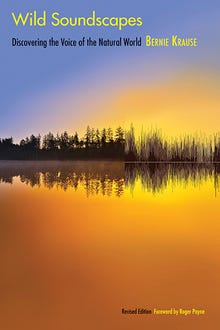Fieldnotes: Environmental Peacemaking, Wild Soundscapes, 'The Natural Learning Initiative' and more...
Weekly fieldnotes in environmental communication

Hi everyone, welcome back to Wild Ones, a bi-weekly digest by me, Gavin Lamb, about news, ideas, research, and tips in environmental communication. If you’re new, welcome! You can read more about why I started Wild Ones here. Sign up here to get these digests in your inbox:
What I’m reading
This week, I’ve delved into some research on the communication strategies environmental nonprofit organizations (ENGOs) use to help amplify their work on issues like sustainability, environmental conservation, and environmental justice:
‘When do environmental NGOs work? A test of the conditional effectiveness of environmental advocacy.’ by Raul Pacheco-Vega. The paper covers a lot of territory. For example, Pacheco-Vega describes the most common communication strategies environmental NGOs (ENGOs) use, like ‘shaming and blaming’ corporations and governments for their environmentally destructive practices. But one idea of his struck a chord with me:
‘The Double Grid’ Framework
Simply put, the Double Grid proposes this: the most successful ENGOs are the ones that 1) operate in countries with greater civil liberties and democratic participation (i.e. the domestic grid) and 2) operate in countries that are more vulnerable to international pressure (i.e. the international grid).
Here are two key takeaway questions environmental NGOs should ask about their organizations, Pacheco-Vega suggests:
Domestic grid question: Are local politicians influenced by (or afraid of) an ENGO’s communication campaign to sway public opinion against them in a particular local region or country?
International grid question: Are local governments influenced by ENGO’s ability to muster international support to boycott, condemn, or divest in the local government? Or can local governments where ENGOs operate safely ignore international pressure created by an ENGO’s international communication and networking campaign?
Green Planet Blues: Critical Perspectives on Global Environmental Politics (2020), edited by Geoffrey Debalco and Ken Conca.
You can find Pacheco-Vega’s essay on the double grid framework in this interesting book. Here’s a brief description: “This unique anthology examines global environmental politics from a range of perspectives and captures the voices of both the powerless and the powerful.”
Environmental Peacemaking (2002), also edited by Ken Conca and Geoffrey Debalco.
“How can environmental cooperation be used to bolster regional peace?”
The book argues that there’s lots of research examining the violence that ensues from environmental crises like droughts, hurricanes, flooding, and pollution. But there’s little research on how solutions to these environmental crises might also be solutions for peacemaking!
The book explores environmental peacemaking efforts involving a range of communication strategies. So needless to say, there’s a lot here to think about for environmental communicators.
Here’s a brief description of the book: “A large body of research suggests that environmental degradation may catalyze violent conflict. Environmental cooperation, in contrast, has gone almost unexplored as a means of peacemaking, even though it opens several effective channels: enhancing trust, establishing habits of cooperation, lengthening the time horizons of decisionmakers, forging cooperative trans-societal linkages, and creating shared regional norms and identities.”
What I’m listening to
Wild Soundscapes, by soundscape ecologist, Bernie Krause.
“A founder of soundscape ecology offers a pioneering field guide for listening to and recording the sounds of the wild.”
“The book enchantingly shows how to find creature symphonies (or, as Krause calls them, “biophonies”); use simple microphones to hear more; and record, mix, and create new expressions with the gathered sounds.”
On the book’s homepage, you can listen to examples of the wild soundscapes Bernie has collected for each chapter.

What I’m watching
David Attenborough: A Life On Our Planet.
David Attenborough, the “celebrated naturalist reflects upon both the defining moments of his lifetime and the devastating changes he has seen…the film addresses some of the biggest challenges facing life on our planet, providing a snapshot of global nature loss in a single lifetime. With it comes a powerful message of hope for future generations as Attenborough reveals the solutions to help save our planet from disaster.”
If you have time, I recommend reading Dharna Noor’s overall positive review that assesses key issues the film could have better communicated: ‘David Attenborough: A Life on Our Planet Nails the Planetary Problems But Misses the Political Ones.’
And while you’re at it, why not watch David Attenborough’s Our Planet from last year, and read science writer Ed Yong’s great review of that film here.
Also of note: “Fat Bear Week Is Finally Here.”
Eco-tools to explore
The Natural Learning Initiative research center at North Carolina State University. One area of research I’ve been exploring is the role of animal and nature-interaction in promoting student well-being and academic success (mostly among international university students). In my research, I’ve come across some interesting research centers exploring this topic in diverse contexts and age-groups around the world. The Natural Learning Initiative is one such research center in North Carolina. Here’s a brief description of the research they do and some of the resources and tools they provide to the public:
“Increasing numbers of children are growing up with insufficient contact with the natural world.
Reasons include childcare centers with outdoor spaces that do not support children’s developmental needs; the rapid growth of domestic air-conditioning since the 1950s; apprehensive parents who keep their children close to home; state-mandated curricula that do not allow time for study outdoors; and the overly-structured, harried lifestyle of many children today.
To counteract this trend, the Natural Learning Initiative offers the following to advance experience of the natural environment in the daily lives of all children: evidence-based design assistance, professional development, and information resources”
Quote I’m pondering
“In terms of environmental messages and how to communicate them, it would be wise to look well beyond the current movement. We need a new set of ‘articulators’ to communicate a fresh, broad view of human relationships and actions toward the natural world. We need charismatic visionaries to spark new social change groups, even a new movement. The struggle over what environment means, the values it holds for all of us, and how we speak and act toward it, is being lost…We need to bring the environment home. The environment needs to be reconnected to our everyday lives, in work and leisure, in words and actions.”
– Julia Corbett, in Communicating Nature: How We Create and Understand Environmental Messages (2006, p. 310).



